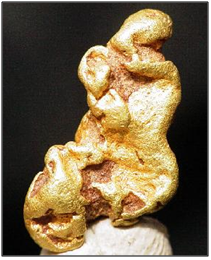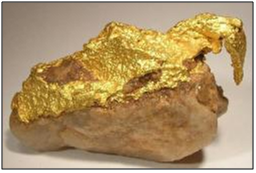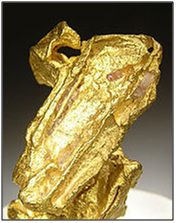Mining at Montacute
From the very early days of European settlement in South Australia, the colonists were keen to explore, find and develop the resources of the land that they had occupied, and there was speculation that there may be minerals in the hills behind the settlement of Adelaide. Within 10 years, both copper and gold had been discovered at Montacute.
The South Australian in 1844 claims that in November 1843 the Deputy Surveyor General, Thomas Burr,
“ discovered copper on Government land among the Mount Lofty ranges, about ten miles north east from Adelaide .” 1
But The News in 1933 claims,
“The Montacute copper mine, once famous, 10 miles from Adelaide, was discovered accidentally by an overseer named Andrew Henderson, who was searching for a strayed bullock.” 2
Whoever discovered it, they were outbid by a syndicate called the Montacute Mining Company who successfully purchased the land when it was put up for auction and operated the Montacute Copper Mine.
“The company employ eight men. The miners have one-tenth tribute money, and the men, judging from what they have already done, calculate on making each £2 per day, at least. They have already excavated about fifty tons of ore. This mine has the remarkable advantage of being on the side of a steep hill, where three lodes have been already found, and are wrought. There is thus no occasion to sink shafts.”1
A member of the syndicate, the Hon. John M Baker, named the area Montacute after his native Montacute because he saw a similarity with the hills around the Montacute Mine.
The mines provided employment to several hundred men and a small community with a church, mine manager’s residence and cemetery developed along Fifth Creek. In April 1848 The South Australian reported on a Temperance Meeting held in the new Wesleyan Chapel at The Montacute Mine.
“The meeting was well attended by both sexes and the addresses, which were of an interesting nature, were listened to by all with great attention.”
After singing and prayer, the happy company sat down to enjoy the cup.
"Which cheers, but not inebriates,"
together with the plentiful supply of cake, &c., provided by the kind-hearted Cornish teetotallers.3
The Montacute area was worked on and off through the nineteenth century, mainly for copper, although the output diminished greatly after the 1851 gold rush to the Victorian goldfields. The Montacute mines didn’t close until the 1890’s.
The ore was loaded on to bullock drays and laboriously hauled up what we call Corkscrew Road, over the range and down Montacute Road to Port Adelaide, because the Gorge Road as we know it wasn’t opened until the 1920’s.
“The grand, the crowning triumph has been accomplished – South Australia seems destined to become the real El Dorado. Metals have already been found and now, at last, gold - the most precious of all - has been discovered.”4
So rang out the headline of The South Australian published on Tuesday April 7, 1846.
Indeed gold had been discovered at the North Montacute Mine, operated by the Victoria Mining Company, located on what we now call Batchelor Road Castambul, approximately 1km north of the original Montacute Copper Mine.
A building was erected over the main mine shaft and guards were posted to watch over the mine twenty-four hours a day. Excitement and demand for scrip in the company was high in Adelaide but those with scrip refused to sell. It was claimed that shares jumped from £2 to £30.
It seems that specimens of gold from the mine, were used by several Adelaide jewellers to mount South Australian gems and a number of smaller pieces were also used to make a ring for William Jury’s son, William Edward, and for a brooch, sent as a gift to Queen Victoria.5
In NSW, small discoveries of gold had been made over the years but they had been kept quiet for fear of what could happen among the convict population if word got out, and the great gold rushes in the eastern states were still 5 years in the future.
Image 1.
So the discovery of gold at Montacute in April 1846 can be recognised as the first authentic discovery to which public attention was drawn and the North Montacute Mine, renamed the Victoria Mine in honour of the queen, can be regarded as the first working gold mine in Australia.
Sadly the grand, the crowning triumph didn’t eventuate. The lode of gold was small and difficult to follow and despite a number of promising announcements over the next few years nothing of substance was unearthed and then in 1851 as the gold rushes to the eastern states began, easier gold was to be had over the border.
As a result of the dramatic effects the Victorian gold-rushes had on South Australia's infant copper mining industry, and its economy in general, the government offered a reward in 1851 for the discovery of a payable goldfield in the colony. The Adelaide Observer reported in December 1851 that,
"Some Germans are vigorously prosecuting a search near the Victoria Mine and express themselves most sanguinely as to their expectation of becoming entitled to the prize of £1000 offered by the Government.”6
Unfortunately no payable gold was discovered.
In 1851, the colony of South Australia included gold from the Victoria Mine in its display at the Crystal Palace Exhibition in London. According to the local papers, a scandal developed after the Exhibition was over, as Messrs Hallet and Sons who had been entrusted with the gold, supposedly passed it to the Worthing Mines Co. who then claimed it was from their mine, presumably to encourage investment in that venture.7
Image 2.
It is difficult to know how much gold was actually mined at The Victoria Mine, but one report mentioned 24 ounces in total and another, 1 kilogram.8
The SA Gazette and Mining Journal in 1851 claimed that the Victoria Mine gave 14ozs. per ton of dirt which was better than the richest mines in the world, and that lack of native labor and good useful machinery saw the venture fall away.9
As late as 1930 the Advertiser reported that there were groups of prospectors looking for gold in the vicinity of Montacute and along the Torrens River. The Great Depression of that time may have played a part in this.10
Mine managers were given the title, “Captain,” following the custom brought by the Cornish miners who worked many of the early copper mines in South Australia.
The first Captain at Montacute was William Jury, an experienced miner. He had been engaged to manage the Montacute and Paringa Mines. In 1847, he met an untimely death when he slipped and fell down the Paringa Mine shaft located in the vicinity of Mt. Barker. His descendants later settled in the Campbelltown district.11
The Jury Family has graciously donated their family bible to the Ian Reddy Local History room in the Campbelltown Library in 2021. In the video below, Local History Officer Helen Thiselton and Jury Family representative Tracey Wade, discuss the connection between the Jury family and the Campbelltown City Council area, including the copper and mines at Montacute.
Captain Samuel Morcom was in charge of the Montacute Mine when the Wesleyan Chapel was built and encouraged his miners to abstain from hard liquor and join the Temperance Movement. In 1848 the South Australian Register reported that,
“Captain Morcom, is a teetotaller of the first water, we might also say a water totaller. He has commenced regular worship four times on Sunday, and twice weekly,…..”12
Captain Thomas Tyrrell (sometimes spelt as Terrell) was in charge of the Victoria Gold Mine when gold was discovered and led the efforts to develop the mine. In 1853, a fall at the Victoria Mine had a much happier ending than that of Captain Jury’s fall at Paringa Mine.

Image 3.
Captain Tyrrell was in the vicinity of the mine shaft with his 4 year-old son, when the boy stepped on some rotting framework which fell 60 feet (20m) down the shaft, taking the boy as well. Captain Tyrrell escaped the fall and could hear the boy below but had no means of getting down the shaft until he remembered an abandoned adit (a horizontal tunnel) extended from the bottom of the shaft to the hillside. Gathering a pick he managed to clear his way along the tunnel until he reached his son who was alive. A Dr. Mayo was called and about 3 hours later he arrived and found that apart from slight bruises on his temple, head, shoulder and hip the boy had no serious injury.
“He was able to walk and eat, and had certainly sustained far less fright than his father.”13
Endnotes:
- For those who would like to view a map showing where some of the mines in the Montacute area were located, visit http://www.mindat.org/loc-19060.html
- Images 1, 2 and 3 are attributed to Rob Lavinsky, iRocks.com – CC-BY-SA-3.0 and can be found on Wikipedia Commons. The nuggets are reportedly from the Victoria Gold Mine. Further information can be found by visiting, https://commons.wikimedia.org/wiki/Category:Victoria_Gold_Mine
Researched and compiled by Geoff Burton, a volunteer with the Campbelltown Library “Digital Diggers” group.
If you have any comments or questions regarding the information in this local history article, please contact the Local History officer on 8366 9357 or hthiselton@campbelltown.sa.gov.au.
References
- 1844 'The Southern Australian.', Southern Australian (Adelaide, SA : 1838 - 1844), 22 March, p. 2, https://trove.nla.gov.au/newspaper/article/71628634
- 1933 'El Dorados.', News (Adelaide, SA : 1923 - 1954), 28 February, p. 4, https://trove.nla.gov.au/newspaper/article/133063848
- 1848 'TEMPERANCE MEETING AT THE MONTACUTE MINE.', South Australian (Adelaide, SA : 1844 - 1851), 28 April, p. 2, https://trove.nla.gov.au/newspaper/article/71611164
- 1846 'The South Australian.', South Australian (Adelaide, SA : 1844 - 1851), 7 April, p. 2, https://trove.nla.gov.au/newspaper/article/71604395
- 1936 'Out among the People.', The Advertiser (Adelaide, SA : 1931 - 1954), 8 December, p. 25, https://trove.nla.gov.au/newspaper/article/74333256
1946 'EARLY GOLD DISCOVERY.', Chronicle (Adelaide, SA : 1895 - 1954), 17 October, p. 34, https://trove.nla.gov.au/newspaper/article/93122312
http://www.southaustralianhistory.com/victoria.htm - 1851 '[No heading].', Adelaide Observer (SA : 1843 - 1904), 27 December, p. 4, https://trove.nla.gov.au/newspaper/page/18836920
- 1853 '[No heading].', Adelaide Times (SA : 1848 - 1858), 3 October, p. 2, https://trove.nla.gov.au/newspaper/page/22707542
1853 'GRAND ROGUERY OF 1851.', Adelaide Times (SA : 1848 - 1858), 18 October, p. 2, https://trove.nla.gov.au/newspaper/article/207121148 - http://lapidaryworld.com/pdf/sa_gold_info.pdf
- 1851 'GOLD DIGGING.', South Australian Gazette and Mining Journal (Adelaide, SA : 1847 - 1852), 13 December, p. 2, https://trove.nla.gov.au/newspaper/article/195943664
- 1930 'PROSPECTING FOR GOLD IN ADELAIDE HILLS.', Observer (Adelaide, SA : 1905 - 1931), 21 August, p. 29, https://trove.nla.gov.au/newspaper/article/164800405
- 1847 'CORONER'S INQUEST ON CAPT. JURY.', South Australian Gazette and Colonial Register (Adelaide, SA : 1845 - 1847), 13 February, p. 3, https://trove.nla.gov.au/newspaper/article/195934595
- 1848 'THE MONTACUTE MINE.', South Australian Register (Adelaide, SA : 1839 - 1900), 22 April, p. 3, https://trove.nla.gov.au/newspaper/article/48728543
- 1853 'No title.', South Australian Register (Adelaide, SA : 1839 - 1900), 7 March, p. 3, https://trove.nla.gov.au/newspaper/article/article38453558


